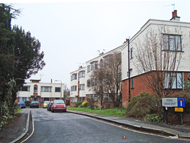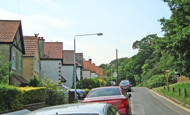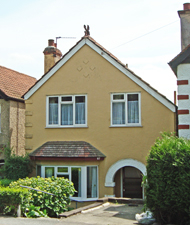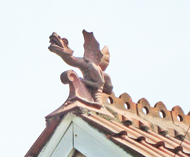Specialist (vegetarian)
The Oriolet Hospital and Convalescent Home opened in 1895, endowed by the prominent vegetarian, Dr Arnold Hills (1857-1927), as a centre of treatment for sick vegetarians. The barrister Mr Josiah Oldfield (1863-1953), an Oxford graduate in law and theology who had adopted vegetarianism whilst a student, was made its Warden.
The Hospital consisted of a Victorian house named Oriolet and an Arts & Crafts open-air ward block with 20 beds. The block was divided by moveable screens which acted as walls; each could be moved to maximise exposure to fresh air. Each section of the block had its own food preparation area (mainly fruit was provided). The 2-acre site on the border of Epping Forest was surrounded by a fence and was large enough to make it unnecessary for patients ever to leave the premises (in fact, they were not allowed to except on very special occasions, and then only with written permission).
Surgical, medical and convalescent cases were admitted without payment or letters of referral. Those suffering from early cancers took priority for admission. Medical records were kept as to the effect of the dietetic treatment (it was said that patients who self-referred themselves from other hospitals were cured).
Patients were not allowed to possess any money; that which they brought with them had to be deposited with the Sister-in-Charge. No patient was allowed to grumble.
The medical press, of course, complained about the faddiness and restrictions of the Hospital's regime - that "for a patient to ask a physician to cure with certain reservations is much like asking a surgeon to cut off a leg with one hand in his breeches pocket". The objection lay in the fact that the patient himself chose to be admitted to a vegetarian hospital rather than the referring physician prescribing such a treatment from the many others available.
In September 1897 Dr Oldfield (he had qualified medically that same year) attended the 4th International Vegetarian Congress in London, where an exhibition of vegetarian products was being held at the same time. (A new vegetable fat Albene was displayed. Without taste or small, it was highly spoken of amongst vegetarians). Dr Oldfield's exhibit consisted of a real baby in a cot and a collection of models of things not actually at the Hospital, but needed there - a bronchitis kettle and tent, hot water bottles, etc.
By 1900 the Hospital had 24 beds - 8 for male patients, 10 for females and 6 for children. Paying patients were charged from 1 guinea (£1.05) a week and ten beds were reserved for poor patients at a fee of 7s 6d (37p) a week; there were four free beds. TB patients were admitted for open-air treatment and those with cancer for dietetic treatment.By the turn of the century Dr Oldfield had resigned as Warden and moved to London to found his own hospital - the Hospital of St Francis - in the New Kent Road.
In May 1903 the Salvation Army took over the Oriolet Hospital. Florence Booth (1861-1957), who was in charge of the Women's Social Work, had been a vegetarian for 15 years and it had been one of her long-cherished ambitions to acquire the property.
The Hospital was renamed the Oriolet Hygienic Home and opened in June 1903 for the treatment of TB patients. Mrs Booth held a press conference, inviting journalists to a fruitarian banquet at the Home, where she explained the raison d'etre of the new departure - that three of God's greatest blessings would be freely used at Oriolet: fresh air, pure food and clean water. The diet would be strictly vegetarian - nuts, fruits and grain - prepared for each individual patient's needs.
Although there would be paying patients, the fees were not large and, as soon as funds permitted, those who were too poor to pay would also be admitted. It was intended to supplement the existing open air wards with revolving open-air shelters. The Home would also offer hydropathic treatments, including Turkish baths.
However, the doctor in charge of the new venture became unwell and no replacement could be found. The Salvation Army was forced to give up the enterprise and, although Mrs Booth hoped to re-establish the hospital in another house, this did not happen.
Present status (December 2010)
In 1908 the premises were taken over by St Ethelburga's Home for Girls, which moved from Kilburn so that the 40 girls (aged from 8 to 14 years) could have space to play and to tend their own little vegetable garden.
The Home closed in 1922 and the building then became the York House Hotel. Part of the site became a tea garden (some of it still remains as the garden of the Wheatsheaf public house) until 1929.
The Hotel was demolished in 1930 and new homes have been built on the site, as well as a new road - York Crescent.
The only remnant of the Oriolet Hospital is a dragon finial on the roof of No. 97 Stapes Road.


The Art Deco-style apartment blocks along York Crescent, built on the site of the Oriolet Hospital.

The dragon finial can be seen on the roof of the second house from the left in Stapes Road.


No. 97 Stapes Road (left) with its dragon finial (right).
(Author unstated) 1897 A medical sack race. British Medical Journal 2 (1920), 1115-1116.
(Author unstated) 2008 York Crescent - and Gandhi - 100 years ago. Hills Amenity Society Newsletter (autumn), 4.
Brown PS 1991 Medically qualified naturopaths and the General Medical Council. Medical History 35, 50-77.
Pond C (2011) A fruitful day in the country. Context 119, 21-22.
Thomson P 2010 Some random recollections of Loughton in the 1890s. Loughton and District Historical Society Newsletter 186, 3.
http://query.nytimes.com
http://rcnarchive.rcn.org.uk
http://trove.nla.gov.au
www.archive.org
www.hillsamenitysociety.co.uk
www.ivu.org
www.loughtonhistoricalsociety.org.uk
www1.salvationarmy.org.uk
Return to home page